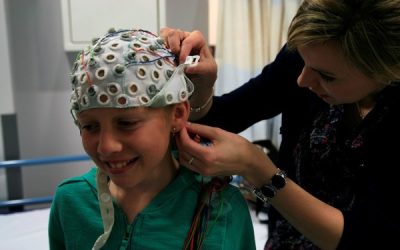The concept of VR technology is not something new, but rather has been around for quite a few decades (McLellan, 1996; Milgram & Kishino, 1994; Sutherland, 1965, 1968; Hoiling, 1961). In the last decade, though, the popularity of iVR has been increasing steadily due to the availability of new VR hardware and software, rendering the technology more affordable, user friendly and accessible than before. These advancements have disrupted a wide range of fields spanning from gaming and entertainment to education, fitness, training, medicine, research and applications (Anton et al., 2009; Bashiri et al., 2017; Krämer, 2017). Especially in the context of behavioral research and applications, this technology has opened up new ways of experimentation and interactive solutions. Let’s take the example of a researcher interested in how multimodal distraction, that is, irrelevant visual and auditory stimuli, affects children’s learning in the classroom. This kind of research would require visits to several physical classrooms or the construction of a dedicated testing classroom. Furthermore, the researcher would have to come up with ideas on how to deliver visual/auditory distraction within these environments. Apart from the economic burden, this approach would fall short of the researcher’s efforts to systematically control important aspects of the testing environments. Instead, the development of an iVR classroom environment would allow for more flexibility and control, thus giving the opportunity for the recreation of any type of situation and interaction. For example, the researcher could customize distraction-related aspects of the virtual classroom (e.g. presentation, type and timing of stimuli) while maintaining systematic control over all the other variables that could potentially influence students’ learning in this setting (Bioulac et al., 2020; Coleman et al., 2019; Rizzo et al., 2006).
From the above, it becomes evident that iVR offers the potential to create simulated assessment and training environments in which relevant variables can be precisely controlled and performance can be tracked in a systematic fashion. Leveraging these strengths of iVR technology, several researchers and practitioners have developed clinical and cognitive applications to evaluate, intervene and manage various medical conditions (Bashiri et al., 2017; Bouchard & Rizzo, 2019; Cho et al., 2019; Fodor et al., 2018; Freeman et al., 2018; Mesa-Gresa et al., 2018). Although iVR-based protocols for children have been around from the beginning of this century (Rizzo 2000, 2006), recent advancements in iVR have accelerated the use of this medium in developmental research (Araiza-Alba et al., 2020) and in pediatric programmes related to pain and anxiety (for a review see, Won et al, 2017), social skills training (Moon & Ke, 2021), problem-solving skills (Araiza-Alba et al., 2021), and cognitive training (Bioulac et al., 2020; Romero-Ayuso et al., 2021).
Of particular interest is the use of iVR in pediatric cognitive training (CT). CT can be defined as the process of enhancing cognitive functions, such as attention and working memory, through the intensive repetition, practice, feedback and steady increase of cognitive difficulty in a set of standardized tasks (Jolles & Crone, 2012). Recent research on this topic has focused on the development of CT interventions for clinical populations, such as children with attention-deficit hyperactivity disorder. In that case, the use of iVR ensures that cognitive abilities are being assessed and/or trained in realistic virtual environments that mimic real-life situations where natural behavior typically occurs. In other words, the use of iVR increases ecological validity (i.e., whether the study’s conclusions are generalizable to real-world contexts) compared to conventional methods, like paper-and-pencil assessments or tasks in flat screens (2D) (Li et al., 2020). In addition, children have the ability to reproduce complex interactions within the virtual environments as many times as necessary until they reach a required level, while their progress is being monitored and evaluated constantly. These elements together with the fun aspect that these kind of programmes incorporate, are crucial especially in case of children with learning difficulties and neurodevelopmental dysfunctions, as they are groups with heterogeneous characteristics and different training needs (Anton et al., 2009; Bouchard & Rizzo, 2019; Cieślik et al., 2020; Slater, 2017; Valentine et al., 2020).
Although recent assessment and training interventions for children have seen the light of the day, the field of evidence-based iVR interventions is still in its infancy. As noted earlier, the new generation of iVR is a relatively new technology and its suitability and effects in children have been relatively underexplored (Bailey & Bailenson, 2017a, 2017b). Since the use of iVR is expected to grow immensely in the next few years, especially in the field of digital therapeutics, it is of utmost importance to understand and address the challenges associated with the use of iVR in children. Together with existing attempts (Yamada-Rice et al., 2017; Aubrey et al., 2018), two of the Neo-Prism-C projects (ESR 12 and ESR 15) will explore the possibilities that this technology holds for 8-12 year olds. These projects will examine the usability, safety and acceptance of this new type of media either in the context of feasibility or CT efficacy studies in typically developing and clinical pediatric populations. We hope that this line of research will contribute to the growing body of evidence showing the potential of iVR programmes for children and will yield new insights on the sensible use of this new medium. Stay tuned for more!
Iouliani Pachiti, University of Crete, Greece and Christos Gkoumas, Silversky 3D Virual Reality Technologies LTD, Cyprus
References:
Anton, R., Orpis, D., Dobrean, A., & David, D. (2009). Virtual reality in the rehabilitation of attention deficit/ hyperactivity disorder. Instrument construction principles. Journal of Cognitive and Behavioral Psychotherapies, 9(2), 235-246. http://search.ebscohost.com/ login.aspx?direct=true&db=asn&AN=44483007&site=ehost-live
Araiza-Alba, P., Keane, T., Beaudry, J. L., & Kaufman, J. (2020). Immersive virtual reality implementations in developmental psychology. International Journal of Virtual Reality, 20. https://doi.org/10.20870/IJVR.2020.20.2.3094
Araiza-Alba, P., Keane, T., Chen, W. S., & Kaufman, J. (2021). Immersive virtual reality as a tool to learn problem-solving skills. Computers & Education, 164, 104121. https://doi.org/ 10.1016/j.compedu.2020.104121
Aubrey, J. S., Robb, M. B., Bailey, J., & Bailenson, J. (2018). Virtual reality 101: what you need to know about kids and VR. URL: http://www. commonsensemedia. org/sites/default/ files/uploads/pdfs/csm_vr101_final. pdf [accessed 2019-02-25][WebCite Cache].
Bashiri, A., Ghazisaeedi, M., & Shahmoradi, L. (2017). The opportunities of virtual reality in the rehabilitation of children with attention deficit hyperactivity disorder: a literature review. Korean Journal of Pediatrics, 60(11), 337-343. https://doi.org/10.3345/kjp.2017.60.11.337
Bailey, J. O., & Bailenson, J. N. (2017a). Immersive virtual reality and the developing child. In Cognitive development in digital contexts (pp. 181-200). Academic Press. https://doi.org/ 10.1016/B978-0-12-809481-5.00009-2
Bailey, J. O., & Bailenson, J. N. (2017b). Considering virtual reality in children’s lives. Journal of Children and Media, 11(1), 107-113. https://doi.org/10.1080/17482798.2016.1268779
Bioulac, S., Micoulaud-Franchi, J. A., Maire, J., Bouvard, M. P., Rizzo, A. A., Sagaspe, P., & Philip, P. (2020). Virtual remediation versus methylphenidate to improve distractibility in children with ADHD: A controlled randomized clinical trial study. Journal of Attention Disorders, 24(2), 326–335. https://doi.org/10.1177/1087054718759751
Bouchard, S., & Rizzo, A. (2019). Applications of virtual reality in clinical psychology and clinical cognitive neuroscience – An introduction. In A. Rizzo, & S. Bouchard (Eds.), Virtual reality for psychological and neurocognitive interventions (pp. 1-13). Springer Nature. https:// doi.org/10.1007/978-1-4939-9482-3
Cieślik, B., Mazurek, J., Rutkowski, S., Kiper, P., Turolla, A., & Szczepańska-Gieracha, J. (2020). Virtual reality in psychiatric disorders: a systematic review of reviews.
Complementary Therapies in Medicine, 52, 102480. https://doi.org/10.1016/ j.ctim.2020.102480
Coleman, B., Marion, S., Rizzo, A., Turnbull, J., & Nolty, A. (2019). Virtual Reality assessment of classroom – related attention: An ecologically relevant approach to evaluating the effectiveness of working memory training. Frontiers in Psychology, 10, 1851. https:// doi.org/10.3389/fpsyg.2019.01851
Fodor, L. A., Coteț, C. D., Cuijpers, P., Szamoskozi, Ș., David, D., & Cristea, I. A. (2018). The effectiveness of virtual reality based interventions for symptoms of anxiety and depression: A meta-analysis. Scientific Reports, 8(1), 10323. https://doi.org/10.1038/s41598-018-28113-6
Freeman, D., Haselton, P., Freeman, J., Spanlang, B., Kishore, S., Albery, E., Denne, M., Brown, P., Slater, M., & Nickless, A. (2018). Automated psychological therapy using immersive virtual reality for treatment of fear of heights: A single-blind, parallel-group, randomized controlled trial. The Lancet Psychiatry, 5(8), 625–632. https://doi.org/10.1016/ S2215-0366(18)30226-8
Heilig, M. (1961). Sensorama. http://en. wikipedia. org/wiki/Sensorama.
Jeffs, T. L. (2010). Virtual reality and special needs. Themes in Science and Technology Education, 2(1-2), 253-268.
Jolles, D. D., & Crone, E. A. (2012). Training the developing brain: A neurocognitive perspective. Frontiers in Human Neuroscience, 6(76). https://doi.org/10.3389/ fnhum.2012.00076
Krämer, N. C. (2017). The immersive power of social interaction: Using new media and technology to foster learning by means of social immersion. In D. Liu, C. Dede, R. Huang, &
- Richards. (Eds.), Virtual, augmented, and mixed realities in education (pp. 55-70). Springer. https://doi.org/10.1007/978-981-10-5490-7
Li, G., Anguera, J. A., Javed, S. V., Khan, M. A., Wang, G., & Gazzaley, A. (2020). Enhanced attention using head-mounted virtual reality. Journal of cognitive neuroscience, 32(8), 1438-1454.
McLellan, H. (1996). Virtual realities. Handbook of research for educational communications and technology, 457-487.
Mesa-Gresa, P., Gil-Gómez, H., Lozano-Quilis, J. A., & Gil-Gómez, J. A. (2018). Effectiveness of virtual reality for children and adolescents with autism spectrum disorder: An evidence-based systematic review. Sensors, 18, 2486. https://doi.org/10.3390/ s18082486
Milgram, P., & Kishino, F. (1994). A taxonomy of mixed reality visual displays. IEICE Transactions on Information and Systems, 77(12), 1321-1329.
Moon, J., & Ke, F. (2021). Exploring the treatment integrity of virtual reality-based social skills training for children with high-functioning autism. Interactive Learning Environments, 29(6), 939-953.
https://doi.org/10.1080/10494820.2019.1613665
Parsons, T. D., Riva, G., Parsons, S., Mantovani, F., Newbutt, N., Lin, L., Venturini, E., & Hall, T. (2017). Virtual reality in pediatric psychology. Pediatrics, 140(Supplement 2), S86- S91.
https://doi.org/10.1542/peds.2016-1758I
Rizzo, A. A., Bowerly, T., Buckwalter, J. G., Klimchuk, D., Mitura, R., & Parsons, T. D. (2006). A virtual reality scenario for all seasons: The virtual classroom. CNS Spectrums, 11(1), 35– 44.
https://doi.org/10.1017/S1092852900024196
Rizzo, A. A., Buckwalter, J. G., Bowerly, T., van der Zaag, C., Humphrey, L., Neumann, U., Chua, C., Kyriakakis, C., van Rooyen, A., & Sisemore, D. (2000). The virtual classroom: A virtual reality environment for the assessment and rehabilitation of attention deficits.
CyberPsychology & Behavior, 3(3), 483–499. https://doi.org/10.1089/10949310050078940
Romero-Ayuso, D., Toledano-González, A., Rodríguez-Martínez, M. D. C., Arroyo-Castillo, P., Triviño-Juárez, J. M., González, P., Ariza-Vega, P., González, A. D. P., & & Segura- Fragoso, A. (2021). Effectiveness of virtual reality-based interventions for children and adolescents with ADHD: A systematic review and meta-analysis. Children, 8(2), 70-88. https://doi.org/10.3390/children80200704
Slater, M. (2017). Implicit learning through embodiment in immersive virtual reality. In D. Liu,Dede, R. Huang, & J. Richards. (Eds.), Virtual, augmented, and mixed realities in education (pp. 19-33). Springer. https://doi.org/10.1007/978-981-10-5490-7
Slater, M. (2009). Place illusion and plausibility can lead to realistic behaviour in immersive virtual environments. Philosophical Transactions of the Royal Society of London B: Biological Sciences, 364(1535), 3549–3557. http://dx.doi.org/10.1098/rstb.2009.0138.
Sutherland, I. E. (1965). The ultimate display. Proceedings of the IFIPS, 2, 506–508.
Sutherland, I. E. (1968). A head-mounted three dimensional display. Proceedings of the Fall Joint Computer Conference, 33, 757–764.
Valentine, A. Z., Brown, B. J., Groom, M. J., Young, E., Hollis, C., & Hall, C. L. (2020). A systematic review evaluating the implementation of technologies to assess, monitor and treat neurodevelopmental disorders: A map of the current evidence. Clinical Psychology Review, 80, 101870. https://doi.org/10.1016/j.cpr.2020.101870
Wang, M., & Reid, D. (2011). Virtual reality in pediatric neurorehabilitation: attention deficit hyperactivity disorder, autism and cerebral palsy. Neuroepidemiology, 36(1), 2-18. https:// doi.org/10.1159/000320847
Won, A. S., Bailey, J., Bailenson, J., Tataru, C., Yoon, I. A., & Golianu, B. (2017). Immersive virtual reality for pediatric pain. Children, 4(7), 52. https://doi.org/10.3390/children4070052
Yamada-Rice, D., Mushtaq, F., Woodgate, A., Bosmans, D., Douthwaite, A., Douthwaite,I., … & Whitley, S. (2017). Children and virtual reality: Emerging possibilities and challenges.






